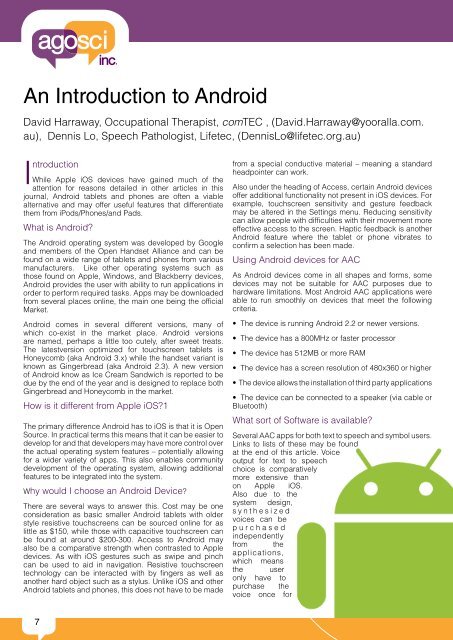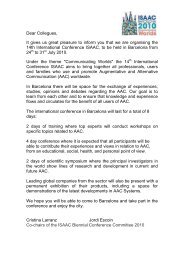Focus - agosci
Focus - agosci
Focus - agosci
Create successful ePaper yourself
Turn your PDF publications into a flip-book with our unique Google optimized e-Paper software.
An Introduction to Android<br />
David Harraway, Occupational Therapist, comTEC , (David.Harraway@yooralla.com.<br />
au), Dennis Lo, Speech Pathologist, Lifetec, (DennisLo@lifetec.org.au)<br />
Introduction<br />
While Apple iOS devices have gained much of the<br />
attention for reasons detailed in other articles in this<br />
journal, Android tablets and phones are often a viable<br />
alternative and may offer useful features that differentiate<br />
them from iPods/Phones/and Pads.<br />
What is Android?<br />
The Android operating system was developed by Google<br />
and members of the Open Handset Alliance and can be<br />
found on a wide range of tablets and phones from various<br />
manufacturers. Like other operating systems such as<br />
those found on Apple, Windows, and Blackberry devices,<br />
Android provides the user with ability to run applications in<br />
order to perform required tasks. Apps may be downloaded<br />
from several places online, the main one being the official<br />
Market.<br />
Android comes in several different versions, many of<br />
which co-exist in the market place. Android versions<br />
are named, perhaps a little too cutely, after sweet treats.<br />
The latestversion optimized for touchscreen tablets is<br />
Honeycomb (aka Android 3.x) while the handset variant is<br />
known as Gingerbread (aka Android 2.3). A new version<br />
of Android know as Ice Cream Sandwich is reported to be<br />
due by the end of the year and is designed to replace both<br />
Gingerbread and Honeycomb in the market.<br />
How is it different from Apple iOS?1<br />
The primary difference Android has to iOS is that it is Open<br />
Source. In practical terms this means that it can be easier to<br />
develop for and that developers may have more control over<br />
the actual operating system features – potentially allowing<br />
for a wider variety of apps. This also enables community<br />
development of the operating system, allowing additional<br />
features to be integrated into the system.<br />
Why would I choose an Android Device?<br />
There are several ways to answer this. Cost may be one<br />
consideration as basic smaller Android tablets with older<br />
style resistive touchscreens can be sourced online for as<br />
little as $150, while those with capacitive touchscreen can<br />
be found at around $200-300. Access to Android may<br />
also be a comparative strength when contrasted to Apple<br />
devices. As with iOS gestures such as swipe and pinch<br />
can be used to aid in navigation. Resistive touchscreen<br />
technology can be interacted with by fingers as well as<br />
another hard object such as a stylus. Unlike iOS and other<br />
Android tablets and phones, this does not have to be made<br />
from a special conductive material – meaning a standard<br />
headpointer can work.<br />
Also under the heading of Access, certain Android devices<br />
offer additional functionality not present in iOS devices. For<br />
example, touchscreen sensitivity and gesture feedback<br />
may be altered in the Settings menu. Reducing sensitivity<br />
can allow people with difficulties with their movement more<br />
effective access to the screen. Haptic feedback is another<br />
Android feature where the tablet or phone vibrates to<br />
confirm a selection has been made.<br />
Using Android devices for AAC<br />
As Android devices come in all shapes and forms, some<br />
devices may not be suitable for AAC purposes due to<br />
hardware limitations. Most Android AAC applications were<br />
able to run smoothly on devices that meet the following<br />
criteria.<br />
• The device is running Android 2.2 or newer versions.<br />
• The device has a 800MHz or faster processor<br />
• The device has 512MB or more RAM<br />
• The device has a screen resolution of 480x360 or higher<br />
• The device allows the installation of third party applications<br />
• The device can be connected to a speaker (via cable or<br />
Bluetooth)<br />
What sort of Software is available?<br />
Several AAC apps for both text to speech and symbol users.<br />
Links to lists of these may be found<br />
at the end of this article. Voice<br />
output for text to speech<br />
choice is comparatively<br />
more extensive than<br />
on Apple iOS.<br />
Also due to the<br />
system design,<br />
synthesized<br />
voices can be<br />
purchased<br />
independently<br />
from the<br />
applications,<br />
which means<br />
the user<br />
only have to<br />
purchase the<br />
voice once for<br />
7





